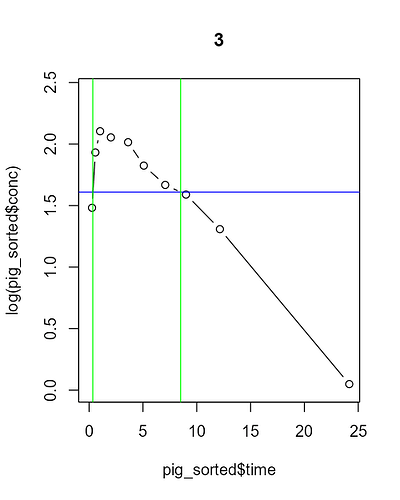Hi all,
I am presenting first the code that is working for me, and the question is under the section MAKE THE GRAPH, for each Subject ID described later on.
I think this may be possible using loops, but I cannot figure out how they work, at least using the two datasets and the different functions.
I have gone as far as making a list with the SUBJECTS from the first dataset (dat_th), but I cannot figure out how to use the list in the functions... I will keep trying and updating this post as I get any further...
Apologies, I haven't find how to make a reprex() with this code, but I have added all the detail to make it reproducible on your end (I Think).
Many thanks for any advise.
Beatriz
Data sets and Packages:
I want to use two different datasets:
- dat: it has the variables I am interested in ( Subject, time and conc)
- dat_th: it has the same variable Subject as the one above , with additional values used in the FUNCTIONS I describe later on.
require(datasets)
library(dplyr)
library(tidyr)
library(purrr)
# Data set:
dat <- Theoph %>%
rename(time = Time )
# Make a additional dataframe with each **Subject**, **th** , "from.1" and "to.1", "from.2" and "to.2"
dat_th <- as.data.frame(unique(Theoph$Subject))
dat_th <- dat_th %>%
mutate(th = 5)%>%
rename(Subject = "unique(Theoph$Subject)")
df <- data.frame(from.1 = c(0.57, 1.00, 0.27, 0.60, 0.30 , 0.58,
0.50, 0.52, 0.01, 0.37, 0.25, 0.5),
to.1 = c(1.12, 1.92, 0.58 ,1.07 , 0.52 , 1.15,
1.02 , 0.98, 0.3, 0.77, 0.5, 1.0 ),
from.2 = c(12.12, 7.03, 7.07, 9.02, 9.10, 3.57,
6.98, 5.05, 5.02, 12.10, 5.02, 9.03),
to.2 = c(24.37, 9, 9, 11.98, 12, 5,
9, 7.15, 7.17, 23.70, 7.03, 12.05))
dat_th <- dat_th %>%
bind_cols (df )
Functions:
# Functions to use
#a)
conc_time_plots_log <- function(pig_ID) {
pig_sorted <- dat |>
filter (Subject == pig_ID)
pig_sorted
plot(pig_sorted$time , log(pig_sorted$conc), type = "b" , ylim=c(log(min(dat$conc+1)), log(max(dat$conc)))) # THIS CODE SETS THE LIMITS OF THE PLOT, using the values from "dat" data.frame.
title(main = pig_ID)
abline(h=log(dat_th%>%
filter(Subject == pig_ID)%>% ### Now it takes the value of "th" from the "dat_th" data.frame, which in this case is column N=2.
select(2)), col="blue")
}
#b)
dat_lm_up_linear <- function(pig_ID){
dat_lm_up <-dat|>
filter (Subject == pig_ID)%>%
filter(time %in% c(dat_th%>%
filter(Subject == pig_ID)%>% ### Now it takes the value of "from.1" and "to.1" from the "dat_th" data.frame, which in this case is column N=3:4.
select(3:4)))
dat_lm_up
lm_up<- lm(dat_lm_up$conc ~ dat_lm_up$time)
lm_up
return(lm_up)
}
#c)
dat_lm_dw_log <- function(pig_ID){
dat_lm_dw <-dat|>
filter (Subject == pig_ID)%>%
filter(time %in% c(dat_th%>%
filter(Subject == pig_ID)%>% ### Now it takes the value of "from.2" and "to.2" from the "dat_th" data.frame, which in this case is column N=5:6.
select(5:6)))
dat_lm_dw
lm_dw<- lm(log(dat_lm_dw$conc)~ dat_lm_dw$time)
lm_dw
return(lm_dw)
}
#d)
IC90_from <- function(pig_ID) {
lm<-dat_lm_up_linear (pig_ID)
th<-dat_th%>%
filter(Subject == pig_ID)%>% ### Now it takes the value of "th" from the "dat_th" data.frame, which in this case is column N=2.
select(2)
a <- (th - lm$coefficients[1])/lm$coefficients[2]
names(a) <- ("IC90_from")
return(c(lm$coefficients[1],
lm$coefficients[2],
th,
a))
}
#e)
IC90_to <- function(pig_ID) {
lm<-dat_lm_dw_log (pig_ID)
th<-dat_th%>%
filter(Subject == pig_ID)%>% ### Now it takes the value of "th" from the "dat_th" data.frame, which in this case is column N=2.
select(2)
a <- (log(th) - lm$coefficients[1])/lm$coefficients[2]
names(a) <- ("IC90_to")
return(c(lm$coefficients[1],
lm$coefficients[2],
th,
a))
}
#f)
Time_over_th <- function(pig_ID) {
result <- (round(
((IC90_to(pig_ID)$IC90_to)- ( IC90_from(pig_ID)$IC90_from)), 2))
return(result)
}
MAKE THE GRAPH, for each Subject ID :
The code above works when I use it in the underneath code for each Subject ID, but I would like:
-
That I don't have to modify manually each of the Subject ID numbers manually, but instead to have a code that runs the ID numbers taken from the dataset dat_th and apply them to the functions.
-
That I can make a new data.frame withthe result from the function Time_over_th(Subject) from each of the Subject IDs.
a) Subject = 1
conc_time_plots_log (1)
IC90_from(1)
lw_lim <- IC90_from(1)$IC90_from
abline(v = lw_lim, col = "green")
IC90_to(1)
up_lim <- IC90_to(1)$IC90_to
abline(v = up_lim, col = "green")
Time_over_th(1)
b) Subject = 12
conc_time_plots_log (12)
IC90_from(12)
lw_lim <- IC90_from(12)$IC90_from
abline(v = lw_lim, col = "green")
IC90_to(12)
up_lim <- IC90_to(12)$IC90_to
abline(v = up_lim, col = "green")
Time_over_th(12)
Update with some new code takes me a bit further.
-
I can make a series of plots with the conc and time columns for each Subject but I haven't find yet how to update those plots with the vertical lines obtained from running the functions stated in the code above.
-
The last line of the code lapply(my_list, Time_over_th) works for this data but not when i use other data.
For other data with same structure I get the following message:
Error in lm.fit(x, y, offset = offset, singular.ok = singular.ok, ...) :
0 (non-NA) cases
I think the message is due to the fact that in my data set I have Subject for which the Time_over_th is zero and the lm() cannot be calculated as the data for the funcion is NA.
my_list <- list()
for (i in 1:nrow(dat_th)) {
my_list[[i]] <- list(dat_th$Subject[i])
}
print(my_list)
lapply(my_list, conc_time_plots_log) #WORKS
lapply(my_list, Time_over_th)
